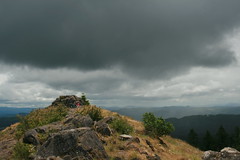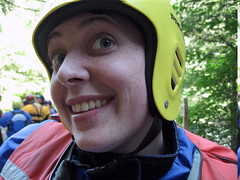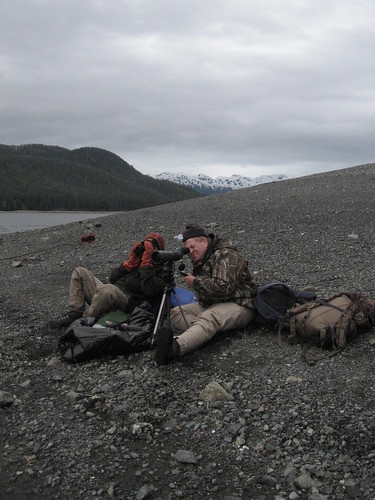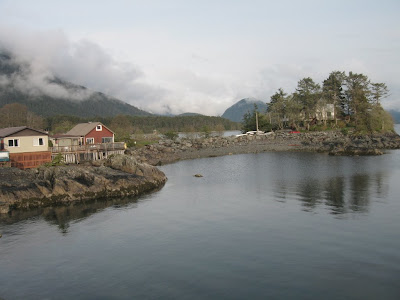You've seen the photos, now the tale of the tape on the recent Alaskan Brown Bear hunt: My dad shot a good representative male bear -- 8'6" (about 700lbs -- a total guess, based entirely on trying to drag the damn thing). He made a 500 yard stalk on a beach, steadied his rifle across a wobbly Swarvoski scope, and shot high at about 100 yards away. As the bear was turning to run, he refocused and dropped it cold with a shot that broke its neck and shoulder, and kicked it over backwards. Coming off of a double bypass just four months previous, the old man pulled it off without a hitch.
We stayed aboard The Bear, a fifty foot boat operated by Alaska Master Guide Brad Dennison of
Alaska Coastal Outfitters. Brad ran the boat and guided my dad’s friend Nick most of the trip. Chet Benson of
Bearfoot Adventures was our guide when my dad shot the bear. I've sworn not to tell where we hunted specifically, but I can say that we hunted the ABC Island area: Admiralty, Baranof and Chicagof.
I have day-to-day notes on the 10-day hunt that I plan to try to tie into a story I'm going to pitch to magazines at some point in the near future.
For most of the trip, I was reading Robert Ruark's
Horn of the Hunter, a book about his safari in Africa. A lot of Ruark's observations seemed to apply to this trip as well. Selected excerpts below:
Every man has to brace a lion at least once in his life, and whether the lion is a woman or a boss or the prospect of death by disease makes no difference.This one's for you Chester:
According to what you may have seen or read, the basic idea of a professional hunter is roughly this: He stands about six foot five, sports a full beard, and is drunk (off his client's liquor) most of the time. He always makes a play for the client's beautiful wife or sister and always scores. He shoots lions with pistols and wrestles snakes and buffalo for fun. When he is not out on safari he hangs around bars in Nairobi, ogling the girls and thumbing the big cartridges he wears in the loops of his jacket. He does all the shooting for the client, while the client sits comfortably in the shooting car. He is always taciturn with a me-Tarzan-you-Jane manner. He has a secret sorrow which drove him to a life among the wild beasts. His business is regarded as butchery and it takes a superhuman man to be a competent butcher.The truth:
The heavy work for a hunter is not so much the location of game and the supervision of the final kill as the camp routine. He supervises a tiny portable city... He must be an expert mechanic -- he must be able to rebuild a motorcar from the spare parts he carries and improvise those parts he has not... The hunter finally combines the duties of sea captain, a bodyguard, a chauffer, a tracker, a skinner, a headwaiter, a tourist guide, a photographer, a mechanic, a stevedore, an interpreter, a game expert, a gin rummy partner, drinking companion, social equal, technical superior, boss, employee, and handyman.
Possibly the best argument for trophy hunting I've ever read:
You are not shooting to kill. You are shooting to make immortal the thing you shoot. To kill just anything is a sin. To kill something that will be dead soon, but is so fine as to give you pleasure for years, is wonderful. Everything dies. You just hasten the process... I can understand killing something that you want so badly that you are willing to go to weeks of trouble and great expense to collect it, so that you will have it and enjoy it and remember it all your life.
This rings of Timothy Treadwell:
I'll never make another one of these things where the first object is the camera, with nothing but dirty work to be done with the gun, mopping up after the humanitarians.
On coming home from a long trip:
All the excitement and dangerous security were finished. Now it would be work and civilian frustration again. All the feeling of complete fatalism was gone. Now the future was in my hands again.


















































